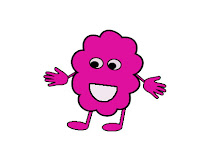Conor Deane
Tuesday 25 October 2011
The 'Lunch Bunch'
Here is a first mock-up of Robin/Rafael/Rupert/Ringo/Ronald/Romilda/Reuben/(insert relevant name here) Raspberry...
He would be just one character in the lunch bunch and i am thinking of using real fruit as the characters to ensure children recognise what it is they should be eating.
Friday 14 October 2011
Target Audience
Tuesday 11 October 2011
My Checklist
Study of Similar Campaigns
It even features tips on how to act, and how to share the idea, through social networking etc. in a 'top 5 actions' bar on the right hand side of the page. The bar can be found on this page...
http://www.jamieoliver.com/us/foundation/jamies-food-revolution/activists
Friday 7 October 2011
Research of Obesity Levels in Primary School Children
Nearly one in four children starting primary school are either overweight or obese, according to government figures which also show that by the time they leave aged 11 the proportion has risen to one in three.
The scale of the epidemic is made clear by yesterday's release of the latest results of the National Child Measurement Programme, which showed that 22.9% of four and five-year-olds are either overweight or obese, indicating that there is a serious problem before children even reach school.
By year 6, it has got worse, with 31.6% of children overweight or obese. In both age groups, boys are more likely than girls to be overweight.
Childhood obesity is more prevalent in London than anywhere else in England and Wales, with 11.3% of four- and five-year-olds and a huge 20.8% of 10- and 11-year-olds having a severe weight problem. The south-east coast has the fewest overweight pupils - 14.9% in the reception class. The south-west has the fewest overweight children in year 6, at 14.9%.
(2008 report by The Guardian)
Very little has changed since this point except the issue gets gradually worse each year.
This is a more recent report by the same paper.
Almost a quarter of children are overweight or obese by the time they start primary school, and more than a third are unhealthily heavy by the time they leave, new NHS statistics reveal.
The data, based on measuring the height and weight of more than a million pupils in England, prompted calls for renewed government action to tackle what experts called the "childhood obesity crisis".
In 2009-10 around 9.8% of four- and five-year-olds were classed as obese when they arrived in reception class. But among 10- and 11-year-olds in year six, that had almost doubled to 18.7%, according to the latest annual figures from the National Child Measurement Programme (NCMP) contained in a report from the NHS Information Centre.
Almost one in four reception pupils was either overweight or obese – 23.1% – while among year six children the figure was 33.4% – more than a third. While both figures are only slightly up on last year, when the equivalent figures were 22.8% and 32.6%, they underline the continuing rise in the number of young children with weight problems.
(December 2010 report by the guardian)
Tuesday 4 October 2011
Research of other campaigns
Jamie Oliver's School Dinners
2005 was a big year for Jamie. Disgusted at what rubbish our kids were getting fed at school, he signed up as a dinner lady to make the Jamie's School Dinners TV series. Jami wanted to show how little government was spending and demand proper standards to get rid of the junk. He had to prove that, for the same price as a bag of crisps, only 37p, he could produce a properly cooked, nutritious meal at lunchtime.
Jamie had no idea that School Dinners was going to start such a massive campaign and that it would get support from parents, teachers, kids and even a few governments all over the world.
Shortly afterwards he wrote the book Jamie's Dinners, to try and provide people with quality options for the way families live now. Most of the recipes use ingredients you can buy in any high street, and you'll find accessible, affordable new ideas for all the old favourites – soups, salads, pasta, meat, fish, desserts, and creative veg.
There's a whole chapter on the not-so-humble sarnie and there's also a section called Family Tree, showing you how, by mastering one core principle, you can expand your repertoire as a cook and start thinking about food in a whole new way.
A year later Jamie revisited the school dinners campaign to see what effect, if any, the government changes had made to schools in Greenwich and beyond, this was documented in Jamie's Return to School Dinners.





